语言学补充练习(1-3)
- 格式:doc
- 大小:47.00 KB
- 文档页数:23
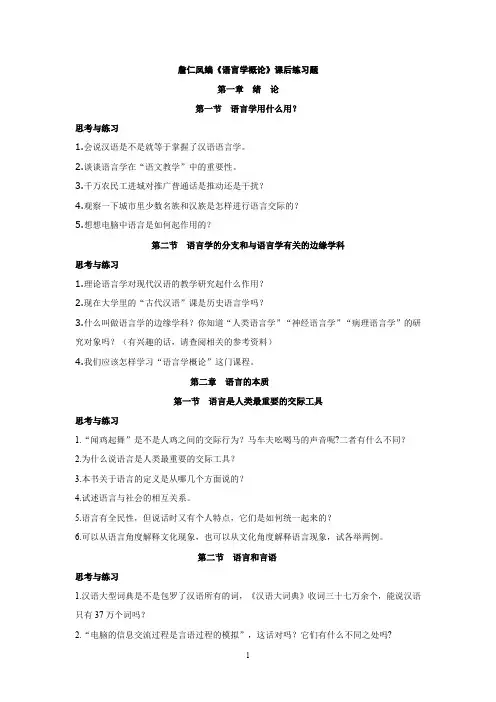
詹仁凤编《语言学概论》课后练习题第一章绪论第一节语言学用什么用?思考与练习1.会说汉语是不是就等于掌握了汉语语言学。
2.谈谈语言学在“语文教学”中的重要性。
3.千万农民工进城对推广普通话是推动还是干扰?4.观察一下城市里少数名族和汉族是怎样进行语言交际的?5.想想电脑中语言是如何起作用的?第二节语言学的分支和与语言学有关的边缘学科思考与练习1.理论语言学对现代汉语的教学研究起什么作用?2.现在大学里的“古代汉语”课是历史语言学吗?3.什么叫做语言学的边缘学科?你知道“人类语言学”“神经语言学”“病理语言学”的研究对象吗?(有兴趣的话,请查阅相关的参考资料)4.我们应该怎样学习“语言学概论”这门课程。
第二章语言的本质第一节语言是人类最重要的交际工具思考与练习1.“闻鸡起舞”是不是人鸡之间的交际行为?马车夫吆喝马的声音呢?二者有什么不同?2.为什么说语言是人类最重要的交际工具?3.本书关于语言的定义是从哪几个方面说的?4.试述语言与社会的相互关系。
5.语言有全民性,但说话时又有个人特点,它们是如何统一起来的?6.可以从语言角度解释文化现象,也可以从文化角度解释语言现象,试各举两例。
第二节语言和言语思考与练习1.汉语大型词典是不是包罗了汉语所有的词,《汉语大词典》收词三十七万余个,能说汉语只有37万个词吗?2.“电脑的信息交流过程是言语过程的模拟”,这话对吗?它们有什么不同之处吗?3.怎样理解“语言存在于言语之中”?4.研究语言现象总免不了举例,这些例证从何而来,试举例说明。
5.怎样理解“语言是从言语中概括出来的模式”?6.学生向老师学习念字可以说是一个模仿的过程,但如果模仿得惟妙惟肖,一丝不走样,反而会受到指责,认为是开玩笑,为什么?第三节语言与思维思考与练习1.为什么说语言也是思维工具?2.宠物猫、狗等“善解人意”,能说明它们也有抽象思维吗?它们跟主人“互相交流”的局限性在哪里?3.新产品的名称往往产生于产品出现之后,有了第一把锄头,语言中才有“锄头”这个词,能不能证明思维先于语言、可以脱离语言?(提示:设计“锄头”时是否要用“锄头”这个词才能思维,有没有其他代替品?)4.语言能够巩固人的认识成果,能举例说明吗?5.说话不合逻辑要受到批评,是不是所有的话都要以逻辑标准定是非?下列句子是否合乎语言规范?秋林公司好热闹。
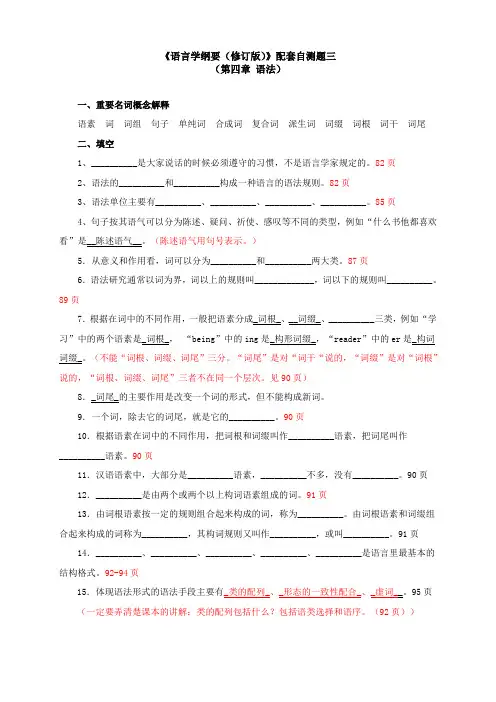
《语言学纲要(修订版)》配套自测题三(第四章语法)一、重要名词概念解释语素词词组句子单纯词合成词复合词派生词词缀词根词干词尾二、填空1、__________是大家说话的时候必须遵守的习惯,不是语言学家规定的。
82页2、语法的__________和__________构成一种语言的语法规则。
82页3、语法单位主要有__________、__________、__________、__________。
85页4、句子按其语气可以分为陈述、疑问、祈使、感叹等不同的类型,例如“什么书他都喜欢看”是__陈述语气__。
(陈述语气用句号表示。
)5.从意义和作用看,词可以分为__________和__________两大类。
87页6.语法研究通常以词为界,词以上的规则叫_____________,词以下的规则叫__________。
89页7.根据在词中的不同作用,一般把语素分成_词根_、__词缀_、__________三类,例如“学习”中的两个语素是_词根_,“being”中的ing是_构形词缀_,“reader”中的er是_构词词缀_。
(不能“词根、词缀、词尾”三分。
“词尾”是对“词干“说的,“词缀”是对“词根”说的,“词根、词缀、词尾”三者不在同一个层次。
见90页)8._词尾_的主要作用是改变一个词的形式,但不能构成新词。
9.一个词,除去它的词尾,就是它的__________。
90页10.根据语素在词中的不同作用,把词根和词缀叫作__________语素,把词尾叫作__________语素。
90页11.汉语语素中,大部分是__________语素,__________不多,没有__________。
90页12.__________是由两个或两个以上构词语素组成的词。
91页13.由词根语素按一定的规则组合起来构成的词,称为__________。
由词根语素和词缀组合起来构成的词称为__________,其构词规则又叫作__________,或叫__________。
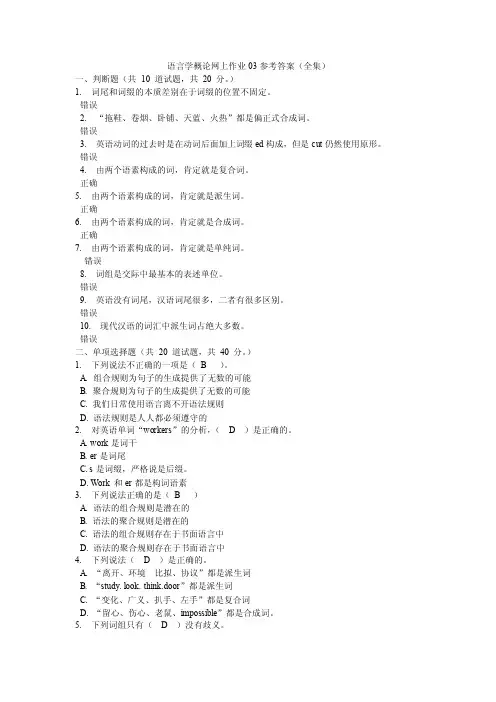
语言学概论网上作业03参考答案(全集)一、判断题(共10 道试题,共20 分。
)1. 词尾和词缀的本质差别在于词缀的位置不固定。
错误2. “拖鞋、卷烟、卧铺、天蓝、火热”都是偏正式合成词。
错误3. 英语动词的过去时是在动词后面加上词缀ed构成,但是cut仍然使用原形。
错误4. 由两个语素构成的词,肯定就是复合词。
正确5. 由两个语素构成的词,肯定就是派生词。
正确6. 由两个语素构成的词,肯定就是合成词。
正确7. 由两个语素构成的词,肯定就是单纯词。
错误8. 词组是交际中最基本的表述单位。
错误9. 英语没有词尾,汉语词尾很多,二者有很多区别。
错误10. 现代汉语的词汇中派生词占绝大多数。
错误二、单项选择题(共20 道试题,共40 分。
)1. 下列说法不正确的一项是(B )。
A. 组合规则为句子的生成提供了无数的可能B. 聚合规则为句子的生成提供了无数的可能C. 我们日常使用语言离不开语法规则D. 语法规则是人人都必须遵守的2. 对英语单词“workers”的分析,( D )是正确的。
A. work是词干B. er是词尾C. s是词缀,严格说是后缀。
D. Work 和er都是构词语素3. 下列说法正确的是(B )A. 语法的组合规则是潜在的B. 语法的聚合规则是潜在的C. 语法的组合规则存在于书面语言中D. 语法的聚合规则存在于书面语言中4. 下列说法( D )是正确的。
A. “离开、环境比拟、协议”都是派生词B. “study. look. think.door”都是派生词C. “变化、广义、扒手、左手”都是复合词D. “留心、伤心、老鼠、impossible”都是合成词。
5. 下列词组只有( D )没有歧义。
A. 两个朋友送的花瓶B. 发现了敌人的哨兵C. 看打球的小女孩D. 两位代表提的建议6. 下列句子符合英语语法规则的是:DA. He am a studentes.B. She is a students.C. I were a student.D. Y ou are a student.7. “John is reading the newspaper”变成被动语态是:DA. The newspaper is reading by John.B. The newspaper is by John reading.C. The newspaper is being read by John.D. The newspaper is being readed by John.8. 下列句子有歧义的一句是:BA. 那里的茶花很多。
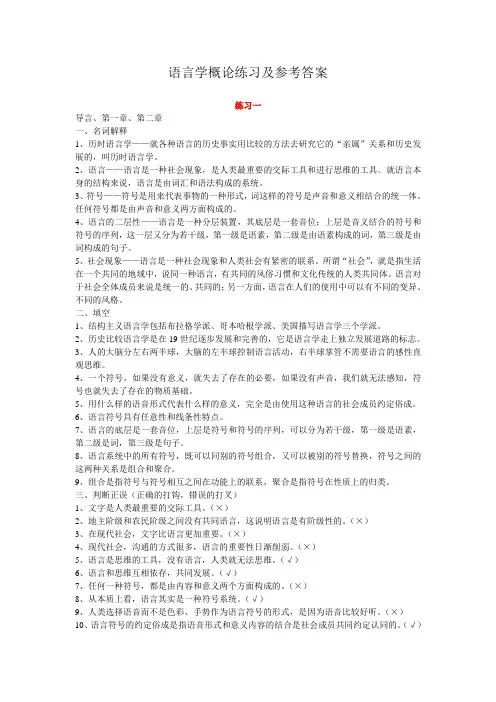
语言学概论练习及参考答案练习一导言、第一章、第二章一、名词解释1、历时语言学——就各种语言的历史事实用比较的方法去研究它的“亲属”关系和历史发展的,叫历时语言学。
2、语言——语言是一种社会现象,是人类最重要的交际工具和进行思维的工具。
就语言本身的结构来说,语言是由词汇和语法构成的系统。
3、符号——符号是用来代表事物的一种形式,词这样的符号是声音和意义相结合的统一体。
任何符号都是由声音和意义两方面构成的。
4、语言的二层性——语言是一种分层装置,其底层是一套音位;上层是音义结合的符号和符号的序列,这一层又分为若干级,第一级是语素,第二级是由语素构成的词,第三级是由词构成的句子。
5、社会现象——语言是一种社会现象和人类社会有紧密的联系。
所谓“社会”,就是指生活在一个共同的地域中,说同一种语言,有共同的风俗习惯和文化传统的人类共同体。
语言对于社会全体成员来说是统一的、共同的;另一方面,语言在人们的使用中可以有不同的变异、不同的风格。
二、填空1、结构主义语言学包括布拉格学派、哥本哈根学派、美国描写语言学三个学派。
2、历史比较语言学是在19世纪逐步发展和完善的,它是语言学走上独立发展道路的标志。
3、人的大脑分左右两半球,大脑的左半球控制语言活动,右半球掌管不需要语言的感性直观思维。
4、一个符号,如果没有意义,就失去了存在的必要,如果没有声音,我们就无法感知,符号也就失去了存在的物质基础。
5、用什么样的语音形式代表什么样的意义,完全是由使用这种语言的社会成员约定俗成。
6、语言符号具有任意性和线条性特点。
7、语言的底层是一套音位,上层是符号和符号的序列,可以分为若干级,第一级是语素,第二级是词,第三级是句子。
8、语言系统中的所有符号,既可以同别的符号组合,又可以被别的符号替换,符号之间的这两种关系是组合和聚合。
9、组合是指符号与符号相互之间在功能上的联系,聚合是指符号在性质上的归类。
三、判断正误(正确的打钩,错误的打叉)1、文字是人类最重要的交际工具。
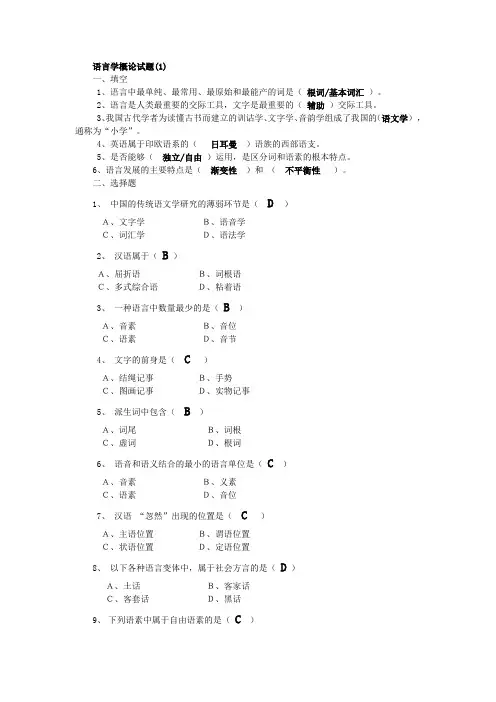
语言学概论试题(1)一、填空1、语言中最单纯、最常用、最原始和最能产的词是(根词/基本词汇)。
2、语言是人类最重要的交际工具,文字是最重要的(辅助)交际工具。
•3、我国古代学者为读懂古书而建立的训诂学、文字学、音韵学组成了我国的(语文学),通称为“小学”。
4、英语属于印欧语系的(日耳曼)语族的西部语支。
•5、是否能够(独立/自由)运用,是区分词和语素的根本特点。
6、语言发展的主要特点是(渐变性)和(不平衡性)。
二、选择题••••••1、中国的传统语文学研究的薄弱环节是( D )••A、文字学B、语音学••C、词汇学D、语法学•2、汉语属于(B)•A、屈折语B、词根语•C、多式综合语D、粘着语•3、一种语言中数量最少的是(B)••A、音素B、音位••C、语素D、音节•4、文字的前身是(C)••A、结绳记事B、手势••C、图画记事D、实物记事•5、派生词中包含(B)••A、词尾B、词根••C、虚词D、根词•6、语音和语义结合的最小的语言单位是(C)••A、音素B、义素••C、语素D、音位7、汉语“忽然”出现的位置是(C)••A、主语位置B、谓语位置••C、状语位置D、定语位置8、以下各种语言变体中,属于社会方言的是(D)•••A、土话B、客家话•••C、客套话D、黑话9、下列语素中属于自由语素的是(C)•••A、初B、视•••C、人D、民能够独立成词,也能够同别的语素组合成词语的语素叫自由语素。
例如:人——人们、人民、人类、人生、众人、强人……电——电灯、电话、电影、电视、闪电、静电……10、在语言结构的某一环节上能够互相替换,•具有某种相同作用的各个单位之间所形成的关系叫(D)••A、转换关系B、组合关系••C、层级关系D、聚合关系三、试以国际音标标出下列各词的读音1、优秀2、维持3、宏观4、精神5、离开四、用义素分析法分析下列各组词1、瞻仰 [+用眼 +往一定方向 +崇敬地]鸟瞰 [+用眼 +往一定方向 +向下]2、生[+存在状态 +开始或继续]死[+存在状态 +结束]五、简答题1、指出汉语普通话a音位的几个条件变体,描述其发音特点和出现条件。

语言学概论作业(一)一、名词解释音素元音音位音位变体:是同一个音位的不同变异形式,是音位在特定语音环境下的具体体现或具体代表语流音变:由于相邻音节的相互影响或表情达意的需要,有些音节的读音要发生一定的变化,这就是语流音变音质音位:由音素成分构成的音位叫音质音位,又因为音质音位出现在固定的音段上,所以又叫音段音位区别特征:有区别音位的作用的发音特征组合关系:在语言结构的同一层级上组合起来的各个单位之间所形成的关系就叫组合关系,又叫句段关系。
(语言符号在时间上是线性展开的,语言单位间的组合也采取线性的序列形式。
不同长度的语言单位的组合可以称为句段,所以组合关系也可以称为“句段关系”。
)聚合关系二、填空1.语音同其它声音一样,也具有音高、音强、音长和音质四个要素。
2.人类的发音器官可分为动力站、发音体、共鸣器三大部分。
3.根据发音特点,音素可以分为元音和辅音两类,例如汉语音节中的声母,主要就是由元音充当的。
4.每个元音的音质是由舌位的高低、舌位的前后、嘴唇的圆展三个方面的因素决定的。
5.根据发音特征描述,写出下列元音:舌面后半高圆唇元音是o ,舌面前低不圆唇元音是 a ,舌面后半低不圆唇元音是v ,舌面前高圆唇元音是i 。
6.辅音的发音特点是由发音部位、发音方法两个方面决定的。
7.描写下列辅音的发音特点:[b]是,[p]是,[ts]是,[g]是,[m]是。
8.指出下列各组辅音的区别特征:[p…]-[p]是送气/不送气,[p]-[b]是浊清,[ts]-[ts…]是送不送气,[f]-[v]是清浊,[t…]-[k…]是舌尖中舌根。
9.音位变体可分条件变体和自由变体两类。
10.以音素为材料进行分析的音位是音质音位,具有区别意义作用的音高、音重、音长这类音位叫做非音质音位。
11.汉语的音节可分为声母、韵母、声调三部分,其中韵母又分韵头、韵腹、韵尾三部分。
12.常见的语流音变主要有轻声、儿化、变调、啊四种,例如汉语的“豆腐”,实际音质是[toufu],但人们说话时常说成[touf],这种现象是脱落。
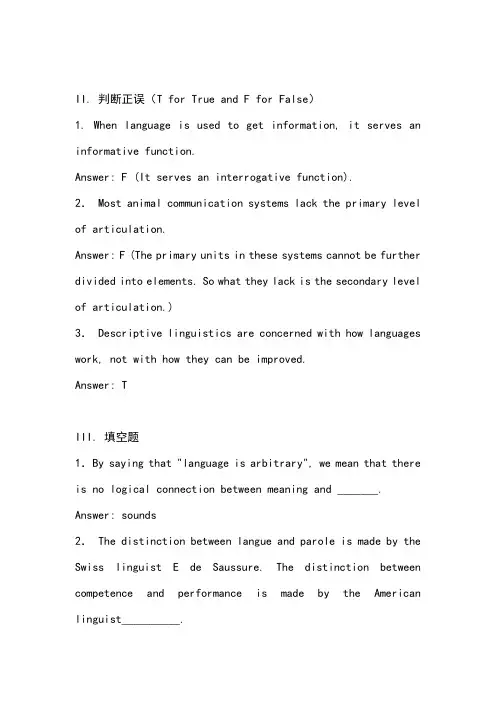
II. 判断正误(T for True and F for False)1. When language is used to get information, it serves an informative function.Answer: F (It serves an interrogative function).2. Most animal communication systems lack the primary level of articulation.Answer: F (The primary units in these systems cannot be further divided into elements. So what they lack is the secondary level of articulation.)3. Descriptive linguistics are concerned with how languages work, not with how they can be improved.Answer: TIII. 填空题1.By saying that "language is arbitrary", we mean that there is no logical connection between meaning and _______. Answer: sounds2. The distinction between langue and parole is made by the Swiss linguist E de Saussure. The distinction between competence and performance is made by the American linguist__________.Answer: Noam Chomsky3. An approach to linguistic study which attempts to lay down rules of correctness as to how language should be used is _______.Answer: prescriptiveIV. 选择题1.Unlike animal communication system, human language is ______.A. stimulus freeB. stimulus boundC. under immediate stimulus controlD. stimulated by some occurrence of communal interest Answer:A2. ____ has been widely accepted as the forefather of modem linguistics.a. Chomskyb. Saussurec. Bloomfieldd. John LyonAnswer: bV. 问答题l. Is language productive or not WhyAnswer: Firstly, Language is productive or creative. This means that language users can understand and produce sentences theyhave never heard before. Secondly, Productivity is unique to human language. Most animal communication systems have a limited repertoire, which is rapidly exhausted, making any novelty impossible. Thirdly, The productivity or creativity of human language originates from its duality. Because of duality, the speaker can combine the basiclinguistic units to form an infinite set of sentences. The productivity of language also means its potential to create endless sentences. This is made possible by the recursive nature of language.2. Comment on the following statement: “In linguistics, ‘language’ only means what a person says or said in a given situation”.Answer: This statement is incorrect. In linguistics, "language" has several layers of meaning: firstly, the whole of a person’s language, . Shakespeare’s language; secondly, a particular variety or level of speech or writing, . scientific language, literary language, colloquial language; thirdly, an abstract system underlying the totality of the speech/writing behavior of a community, . the English language, the Chinese language; lastly, there is an even more abstract sense of "language", referring to the common features of all humanlanguages that distinguish them from animal communication systems or any artificial language.3. Point out three ways in which linguistics differs from traditional grammar.Answer: Firstly, most linguistic analyses today focus on speech rather than writing. Secondly, modem linguistics is mostly descriptive while traditional grammar is largely prescriptive. Thirdly, a third difference is the priority of synchronic description over the traditional diachronic studies.4. What is the major difference between Saussure' s distinction between langue and parole and Chomsky's distinction between competence and performanceAnswer: Saussure’s langue is social product, a set of conventions for a speech community. Chomsky regards competence as a property of the mind of each individual. Saussure studies language more from a sociological point of view while Chomsky studies it more from a psychological point of view.第二章语音学和音位学I. 名词解释1.narrow transcriptionAnswer: There are two ways to transcribe speech sounds. One is the “broad transcription”----the transcription with letter-symbols only, and the other is “narrow transc ription”---the transcription with letter-symbols accompanied by the diacritics which can help bring out the finer distinctions than the letters alone may possibly do.2. Illustrate the term “allophone” with at least one appropriate example.Answer: Allophones are the different members of a phoneme, sounds which are phonetically different but do not make one word different from another in meaning. For example, in English, the phoneme /l/ is pronounced differently in "let", "play" and "tell". The first /l/ is made by raising the front of the tongue to the hard palate, while the vocal cords are vibrating; the second /l/ is made with the same tongue position as the first, but the vocal cords are not vibrating; and the third /l/ is made by raising not only the front by also the back of the tongue while the vocal cords are vibrating.II 判断正误(T for True and F for False)1. /o/ is a mid-high front rounded vowel.Answer: F. (/o/ is a mid-high BACK rounded vowel.)2. A phoneme in one language or one dialect may be an allophone in another language or dialect.Answer: T.III. 填空题:1. The three cavities in the articulatory apparatus are _____, _______, and _____.Answer: pharynx, the nasal cavity, the oral cavity2. By the position of the ____ part of the tongue, vowels and classified as front vowels, central vowels and back vowels. Answer: highest.3. ____refers to the change of a sound as a result of the influence of an adjacent sound.Answer: Assimilation.4. You are required to fill in the blanks below abiding by the instance given beforehand.Example: /p/: voiced bilabial stop/s/: ________________/g/:_______________/tʃ/:______________/t/: _______________/f /: _______________Answer:/s/: voiceless alveolar fricative/g/: voiced velar stop/tʃ/: voiceless alveo-palatal/post-alveolar affricate/ t /: voiced dental fricative/f /: voiceless labiodental fricative5. Which of the following words would be treated as minimal pairs and minimal setspat, pen more, heat, tape, bun, fat, ban, chain, tale, bell, far, meal, vote, bet, heel, ten, men, pit, main, hit, eat, man Answer:pat, fat; pat, pit; pit, hit;pen, ten; ten, men;heat, eat; heat, heel;tape, tale;bun, ban;chain, main;bell, bet;meal, heel;man, men, main.IV. 选择题1. All syllables contain a(n) _______.a. nucleusb. codac. onsetAnswer: a2. _____is one of the supersegmental features.a. Stopb. Voicingc. Deletiond. ToneAnswer: d3. Which of the following consonants does not exist in Englisha. dental stopb. bilabial stopc. alveolar stopd. velar stopAnswer: a4. _____is not an English consonant.a. Labiodental plosiveb. Alveolar nasalc. Velar stopd. Dental fricativeAnswer: aV. 辨音选择1. What are the distinctive features that group the following sounds in these sets1) /f, v ,s/2) /p, f, b/3) /g, z, b/4) /k, g, w/5) /m, n, ŋ/Answer: 1) fricative 2) obstruent 3) voiced 4) velar5) nasal2. There is one segment that does not belong to the natural class in each of the following groups of speech sounds. You are required to identify that segment and label the natural class, using a descriptive term as specific as possible.a) /m/, /n/, /w/, / ŋ /b) /v/, /w/, /z/, /t/c) /n/, /f/, /l/, /s/, /t/, /d/, /z/Answer:1) /w/ is a semi-vowel, and the others are all nasals.2) /t/ is voiceless, and the others are voiced.3) /f/ is labiodental, and the rest are alveolarVI. 问答题1.Circle the words that contain a sound as required:1) a low vowel: pipe, gather, article, leave, cook2) a bilabial consonant: cool, lad, leap, bomb, push3) an approximant: luck, boots, word, once, table4) a front vowel: god, neat, pit, lush, cook5) a velar: god, fast, chat, lake, quick2.Exemplify the relationship between phone, phoneme and allophone.Answer: Firstly, a “phone” is a phonetic unit or segment. The speech sounds we hear and produce during linguistic communication are all phones. Phones may or may not distinguish meaning. Secondly, a "phoneme" is a phonological unit that is of distinctive value. As an abstract unit, a phoneme is not any particular sound. It is represented or realized by a certain phone in a certain phonetic context. Thirdly, the phones representing a phoneme are called its "allophones". How a phoneme is represented by a phone, or which allophone is to be used, is determined by the phonetic context in which it occurs.But the choice of an allophone is not random but rule-governed in most cases.3.When we are pronouncing the following phrases, how do we actually articulate the "n" sound in the word "ten" Do we still pronounce it as /n/1) ten houses 2) ten teachers 3) ten colleges 4) ten pupils 5) ten buildings 6) ten classesAnswer: 1) /n/2) /n/3) / ŋ /4) /m/5) /m/6) / ŋ /4.How many functions do the vocal cords have in the production of speech soundsAnswer: They have three functions: to make a glottal stop, to produce a voiced sound and to produce a voiceless sound.第三章形态学I. 名词解释1.morphemeAnswer: The morpheme is the smallest unit in terms of relationship between expression and content, a unit which cannot be divided without destroying or drastically altering its meaning, whether it is lexical or grammatical. For instance, the word "barks" in "The dog barks" consists of two morphemes ― "bark" and "-s", neither of which can be further divided into other smaller meaningful units.2.lexemeAnswer: The term "lexeme" is postulated to reduce the ambiguity of the term "word". It is the abstract unit underlying the smallest unit in the lexical system of a language, which appears in different grammatical contexts. For example, "write" is the lexeme of the following set of words: "writes", "wrote", "writing", "written".3.inflectional morphemesAnswer: Inflectional morphemes are also called inflectional affixes. They manifest various grammatical relations or grammatical categories such as number, tense, degree and case. In English, all inflectional morphemes are suffixes, . -(e)s, -ing, -(e)d, -est.II. 判断正误1. A root is not always a free form.Answer: T (There are such bound roots as “-ceive”.)III. 填空题1.Polymorphemic words other than compounds have two parts: the roots and the ____.Answer: affixes2.On, before and together are_____words ― they are words which do not take inflectional endings.Answer: grammatical (functional/form)IV.选择题1."Radar" is a/an____.a. acronymb. blendingc. coinaged. clippingAnswer: a2.Compound words consist of______ morphemes.a. boundb. freec. both bound and freeAnswer: bV. 匹配题Match each expression under A with the one statement under B that characterizes it.A B1. a noisy crow a. compound noun2. eat crow b. root morpheme plus derivational prefix3. scarecrow c. phrase consisting of an adjective plus noun4. the crow d. root morpheme plus inflection affix5. crowlike e. root morpheme plus derivational suffix6. crows f. grammatical morpheme followed by lexical morphemeg. idiomAnswer: 1. c 2. g 3. a 4. f 5. e 6. dVI. 问答题1. Divide the following words into Roots, IA (inflectional affix) and/or DA (derivational affix).1) transformations 2) looseleaves3) destructive 4) geese 5) misled Answer:1) trans- (DA) form (Root) -ation (DA) s (IA)2) loose (Root) leave (Root) s (IA)3) de- (DA) struct (Root) -ive (DA)4) geese (IA)5) mis- (DA) led (IA)2. Label the morphological category of the morphemes underlined in each of the English expressions.a) I' ve been here.b) transformc) oxend) recurAnswer: a) bound morpheme b) derivational prefix c) inflectional suffix d) bound root3. Each of the following Persian words is poly-morphemic. You are required to match each of the notions given below with amorpheme in Persian. (Note that xar means "buy" and -id designates the past tense).xaridiYou (singular) bought.naxaridamI did not buy.namixaridandThey were not buying.xaridHe bought.naxaridimWe did not buy.mixaridHe was buying.mixarididYou (plural) were buying.xaridamI bought.Match each of the notions given below with a morpheme in Persian:a) Ib) you (singular)c) notd) was/were V-ing (continuous)Answer: a) amb) ic) nad) miVid4.It is a fact that morphological processes may be sensitiveto certain phonological context. The English data given belowillustrate this fact. You are required to state thephonological contexts where the addition of -en is possible.a bwhiten *bluenmadden *stupidenredden *greenenFatten *fartheren quicken *slowen deafen *difficultenLiven *abstractenharden *shallowensoften *angryendeepen *vividenAnswer: The suffix -en, which attaches to adjectives to form verbs, can only attach to monosyllabic bases ending in oral stops or fricatives.VerbAdjective-en if Adjective ends in an obstruent (oral stop or fricative). - <Φ> if Adjective ends in a sonorant (nasal, approximant, vowel)Meaning: to make (more) Adjectives5.The word uneasiness may be analyzed in either of the two ways below. You are required to find an argument to support one of the two analyses.a)NPrefixNoununAdjectiveSuffixeasinessb)NAdjectiveSuffixPrefixAdjectivenessuneasiAnswer: b) is the correct analysis, because un- only attaches to adjectives to form other adjectives. Un- cannot be attached to a noun.。

语言学补充练习(1-3)第一章语言学入门知识:I. 名词解释1.cultural transmission (as a defining property of language) Answer: While human capacity for language has a genetic basis, the details of any language system are not genetically transmitted, but instead have to be taught and learned. An English speaker and a Chinese speaker are both able to use a language, but they are not mutually intelligible. This shows that language is culturally transmitted. It is passed on from one generation to the next through teaching and learning, rather than by instinct. In contrast, animal call systems are genetically transmitted. They are born with the capacity to produce the set of calls peculiar to their species.2. descriptive linguistics vs. prescriptive linguisticsAnswer: A linguistic study is descriptive if it describes and analyses facts observed; it is prescriptive if it tries to lay down rules for "correct" behavior. Linguistic studies before the 204 century are largely prescriptive whereas modem linguistic is mostly descriptive.II. 判断正误(T for True and F for False)1. When language is used to get information, it serves an informative function.Answer: F (It serves an interrogative function).2. Most animal communication systems lack the primary level of articulation.Answer: F (The primary units in these systems cannot be further divided into elements. So what they lack is the secondary level of articulation.) 3. Descriptive linguistics are concerned with how languages work, not with how they can be improved.Answer: TIII. 填空题1.By saying that "language is arbitrary", we mean that there is no logical connection between meaning and _______.Answer: sounds2. The distinction between langue and parole is made by the Swiss linguist E de Saussure. The distinction between competence and performance is made by the American linguist__________.Answer: Noam Chomsky3. An approach to linguistic study which attempts to lay down rules of correctness as to how language should be used is _______.Answer: prescriptiveIV. 选择题1.Unlike animal communication system, human language is ______.A. stimulus freeB. stimulus boundC. under immediate stimulus controlD. stimulated by some occurrence of communal interestAnswer:A2. ____ has been widely accepted as the forefather of modem linguistics.a. Chomskyb. Saussurec. Bloomfieldd. John LyonAnswer: bV. 问答题l. Is language productive or not? Why?Answer: Firstly, Language is productive or creative. This means that language users can understand and produce sentences they have never heard before. Secondly, Productivity is unique to human language. Most animal communication systems have a limited repertoire, which is rapidly exhausted, making any novelty impossible. Thirdly, The productivity or creativity of human language originates from its duality. Because of duality, the speaker can combine the basiclinguistic units to form an infinite set of sentences. The productivity of language also means its potential to create endless sentences. This is made possible by the recursive nature of language.2. Comment on the following statement: “In linguistics, ‘language’ only means what a person says or said in a given situation”.Answer: This statement is incorrect. In linguistics, "language" has several layers of meaning: firstly, the whole of a person’s language, e.g. Shakespeare’s language; secondly, a particular variety or level of speech or writing, e.g. scientific language, literary language, colloquial language; thirdly, an abstract system underlying the totality of the speech/writing behavior of a community, e.g. the English language, the Chinese language; lastly, there is an even more abstract sense of "language", referring to the common features of all human languages that distinguish them from animal communication systems or any artificial language.3. Point out three ways in which linguistics differs from traditional grammar.Answer: Firstly, most linguistic analyses today focus on speech rather than writing. Secondly, modem linguistics is mostly descriptive while traditional grammar is largely prescriptive. Thirdly, a third difference is the priority of synchronic description over the traditional diachronic studies.4. What is the major difference between Saussure' s distinction between langue and parole and Chomsky's distinction between competence and performance?Answer: Saussure’s langue is social product, a set of conventions for a speech community. Chomsky regards competence as a property of the mind of each individual. Saussure studies language more from a sociological point of view while Chomsky studies it more from a psychological point of view.第二章语音学和音位学I. 名词解释1.narrow transcriptionAnswer: There are two ways to transcribe speech sounds. One is the “broad transcription”----the transcription with letter-symbols only, and the other is “narrow transcription”---the transcription with letter-symbols accompanied by the diacritics which can help bring out the finer distinctions than the letters alone may possibly do.2. Illustrate the term “allophone” with at least one appropriate example. Answer: Allophones are the different members of a phoneme, sounds which are phonetically different but do not make one word different from another in meaning. For example, in English, the phoneme /l/ is pronounced differently in "let", "play" and "tell". The first /l/ is made byraising the front of the tongue to the hard palate, while the vocal cords are vibrating; the second /l/ is made with the same tongue position as the first, but the vocal cords are not vibrating; and the third /l/ is made by raising not only the front by also the back of the tongue while the vocal cords are vibrating.II 判断正误(T for True and F for False)1. /o/ is a mid-high front rounded vowel.Answer: F. (/o/ is a mid-high BACK rounded vowel.)2. A phoneme in one language or one dialect may be an allophone in another language or dialect.Answer: T.III. 填空题:1. The three cavities in the articulatory apparatus are _____, _______, and _____.Answer: pharynx, the nasal cavity, the oral cavity2. By the position of the ____ part of the tongue, vowels and classified as front vowels, central vowels and back vowels.Answer: highest.3. ____refers to the change of a sound as a result of the influence of an adjacent sound.Answer: Assimilation.4. You are required to fill in the blanks below abiding by the instance given beforehand.Example: /p/: voiced bilabial stop/s/: ________________/g/:_______________/tʃ/:______________/t/: _______________/f /: _______________Answer:/s/: voiceless alveolar fricative/g/: voiced velar stop/tʃ/: voiceless alveo-palatal/post-alveolar affricate/ t /: voiced dental fricative/f /: voiceless labiodental fricative5. Which of the following words would be treated as minimal pairs and minimal sets?pat, pen more, heat, tape, bun, fat, ban, chain, tale, bell, far, meal, vote, bet, heel, ten, men, pit, main, hit, eat, manAnswer:pat, fat; pat, pit; pit, hit;pen, ten; ten, men;heat, eat; heat, heel;tape, tale;bun, ban;chain, main;bell, bet;meal, heel;man, men, main.IV. 选择题1. All syllables contain a(n) _______.a. nucleusb. codac. onsetAnswer: a2. _____is one of the supersegmental features.a. Stopb. Voicingc. Deletiond. ToneAnswer: d3. Which of the following consonants does not exist in English?a. dental stopb. bilabial stopc. alveolar stopd. velar stopAnswer: a4. _____is not an English consonant.a. Labiodental plosiveb. Alveolar nasalc. Velar stopd. Dental fricativeAnswer: aV. 辨音选择1. What are the distinctive features that group the following sounds in these sets?1) /f, v ,s/2) /p, f, b/3) /g, z, b/4) /k, g, w/5) /m, n, ŋ/Answer: 1) fricative 2) obstruent 3) voiced 4) velar5) nasal2. There is one segment that does not belong to the natural class in each of the following groups of speech sounds. You are required to identify that segment and label the natural class, using a descriptive term as specific as possible.a) /m/, /n/, /w/, / ŋ /b) /v/, /w/, /z/, /t/c) /n/, /f/, /l/, /s/, /t/, /d/, /z/Answer:1) /w/ is a semi-vowel, and the others are all nasals.2) /t/ is voiceless, and the others are voiced.3) /f/ is labiodental, and the rest are alveolarVI. 问答题1.Circle the words that contain a sound as required:1) a low vowel: pipe, gather, article, leave, cook2) a bilabial consonant: cool, lad, leap, bomb, push3) an approximant: luck, boots, word, once, table4) a front vowel: god, neat, pit, lush, cook5) a velar: god, fast, chat, lake, quick2.Exemplify the relationship between phone, phoneme and allophone. Answer: Firstly, a “phone” is a phonetic unit or segment. The speech sounds we hear and produce during linguistic communication are all phones. Phones may or may not distinguish meaning. Secondly, a "phoneme" is a phonological unit that is of distinctive value. As an abstract unit, a phoneme is not any particular sound. It is represented or realized by a certain phone in a certain phonetic context. Thirdly, thephones representing a phoneme are called its "allophones". How a phoneme is represented by a phone, or which allophone is to be used, is determined by the phonetic context in which it occurs. But the choice of an allophone is not random but rule-governed in most cases.3.When we are pronouncing the following phrases, how do we actually articulate the "n" sound in the word "ten"? Do we still pronounce it as /n/?1) ten houses 2) ten teachers 3) ten colleges 4) ten pupils 5) ten buildings 6) ten classesAnswer: 1) /n/2) /n/3) / ŋ /4) /m/5) /m/6) / ŋ /4.How many functions do the vocal cords have in the production of speech sounds?Answer: They have three functions: to make a glottal stop, to produce a voiced sound and to produce a voiceless sound.第三章形态学I. 名词解释1.morphemeAnswer: The morpheme is the smallest unit in terms of relationship between expression and content, a unit which cannot be divided without destroying or drastically altering its meaning, whether it is lexical or grammatical. For instance, the word "barks" in "The dog barks" consists of two morphemes ― "bark" and "-s", neither of which can be further divided into other smaller meaningful units.2.lexemeAnswer: The term "lexeme" is postulated to reduce the ambiguity of the term "word". It is the abstract unit underlying the smallest unit in the lexical system of a language, which appears in different grammatical contexts. For example, "write" is the lexeme of the following set of words: "writes", "wrote", "writing", "written".3.inflectional morphemesAnswer: Inflectional morphemes are also called inflectional affixes. They manifest various grammatical relations or grammatical categories such asnumber, tense, degree and case. In English, all inflectional morphemes are suffixes, e.g. -(e)s, -ing, -(e)d, -est.II. 判断正误1. A root is not always a free form.Answer: T (There are such bound roots as “-ceive”.)III. 填空题1.Polymorphemic words other than compounds have two parts: the roots and the ____.Answer: affixes2.On, before and together are_____words ― they are words which do not take inflectional endings.Answer: grammatical (functional/form)IV.选择题1."Radar" is a/an____.a. acronymb. blendingc. coinaged. clippingAnswer: a2.Compound words consist of______ morphemes.a. boundb. freec. both bound and freeAnswer: bV. 匹配题Match each expression under A with the one statement under B that characterizes it.A B1. a noisy crow a. compound noun2. eat crow b. root morpheme plus derivational prefix3. scarecrow c. phrase consisting of an adjective plus noun4. the crow d. root morpheme plus inflection affix5. crowlike e. root morpheme plus derivational suffix6. crows f. grammatical morpheme followed by lexical morphemeg. idiomAnswer: 1. c 2. g 3. a 4. f 5. e 6. dVI. 问答题1. Divide the following words into Roots, IA (inflectional affix) and/or DA (derivational affix).1) transformations 2) looseleaves3) destructive 4) geese 5) misledAnswer:1) trans- (DA) form (Root) -ation (DA) s (IA)2) loose (Root) leave (Root) s (IA)3) de- (DA) struct (Root) -ive (DA)4) geese (IA)5) mis- (DA) led (IA)2. Label the morphological category of the morphemes underlined in each of the English expressions.a) I' ve been here.b) transformc) oxend) recurAnswer: a) bound morpheme b) derivational prefix c) inflectional suffix d) bound root3. Each of the following Persian words is poly-morphemic. You are required to match each of the notions given below with a morpheme in Persian. (Note that xar means "buy" and -id designates the past tense). xaridiYou (singular) bought.naxaridamI did not buy.namixaridandThey were not buying.xaridHe bought.naxaridimWe did not buy.mixaridHe was buying.mixarididYou (plural) were buying.xaridamI bought.Match each of the notions given below with a morpheme in Persian:a) Ib) you (singular)c) notd) was/were V-ing (continuous)Answer: a) amb) ic) nad) miVid4.It is a fact that morphological processes may be sensitive to certain phonological context. The English data given below illustrate this fact. You are required to state the phonological contexts where the addition of -en is possible.a bwhiten *bluenmadden *stupidenredden *greenenFatten *fartheren quicken *slowendeafen *difficultenLiven *abstractenharden *shallowensoften *angryendeepen *vividenAnswer: The suffix -en, which attaches to adjectives to form verbs, can only attach to monosyllabic bases ending in oral stops or fricatives. VerbAdjective-en if Adjective ends in an obstruent (oral stop or fricative).- <Φ> if Adjective ends in a sonorant (nasal, approximant, vowel) Meaning: to make (more) Adjectives5.The word uneasiness may be analyzed in either of the two ways below. You are required to find an argument to support one of the two analyses.a)NPrefixNoununAdjectiveSuffixeasinessb)NAdjectiveSuffixPrefixAdjectivenessuneasiAnswer: b) is the correct analysis, because un- only attaches to adjectives to form other adjectives. Un- cannot be attached to a noun.。
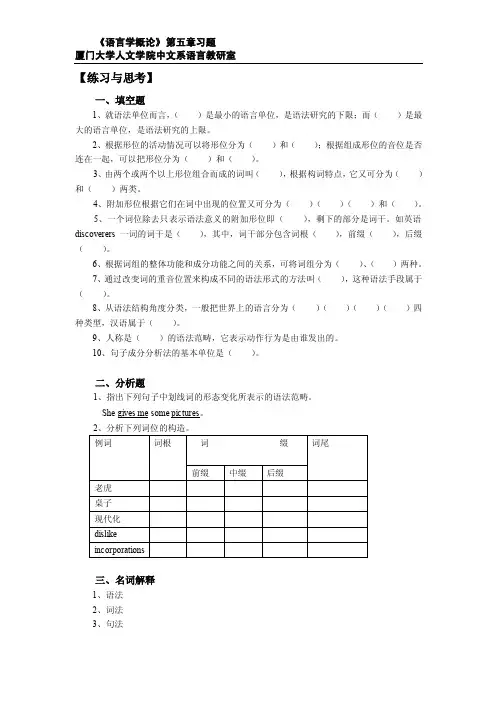
【练习与思考】一、填空题1、就语法单位而言,()是最小的语言单位,是语法研究的下限;而()是最大的语言单位,是语法研究的上限。
2、根据形位的活动情况可以将形位分为()和();根据组成形位的音位是否连在一起,可以把形位分为()和()。
3、由两个或两个以上形位组合而成的词叫(),根据构词特点,它又可分为()和()两类。
4、附加形位根据它们在词中出现的位置又可分为()()()和()。
5、一个词位除去只表示语法意义的附加形位即(),剩下的部分是词干。
如英语discoverers一词的词干是(),其中,词干部分包含词根(),前缀(),后缀()。
6、根据词组的整体功能和成分功能之间的关系,可将词组分为()、()两种。
7、通过改变词的重音位置来构成不同的语法形式的方法叫(),这种语法手段属于()。
8、从语法结构角度分类,一般把世界上的语言分为()()()()四种类型,汉语属于()。
9、人称是()的语法范畴,它表示动作行为是由谁发出的。
10、句子成分分析法的基本单位是()。
二、分析题1、指出下列句子中划线词的形态变化所表示的语法范畴。
She gives me some pictures。
2、分析下列词位的构造。
三、名词解释1、语法2、词法3、句法4、形位5、形位变体6、自由形位7、粘着形位8、词位9、构形法10、构词法11、词组12、句子13、词根形位14、附加形位15、后缀16、中缀17、词尾18、词干19、语法意义20、语法形式21、语法手段22、综合性手段23、分析性手段24、形态25、内部屈折、26、异根法27、附加法28、零形态29、语法范畴30、句法关系31、句法结构32、句型四、思考题1、什么是语法?语法的主要性质特征是什么?2、词法和句法有何联系与区别?3、形位与词位有何区别?4、词位和词组的区别是什么?5、词组和句子有哪些差别?6、什么是词根形位?什么是附加形位?后缀与词尾有什么区别?7、构词法和构形法有什么区别?8、常见的语法手段有哪些?9、根据词的形态特点(语法形式),可把语言大致分成几类?10、举例说明什么是语法范畴?11、词类的划分标准主要有哪些?12、语法意义和语法形式是什么关系?13、主要的句法结构类型有哪些?14、句法结构对词形式的制约大致有哪几种情况?15、常见的句子扩展与变换手段有哪些?16、句子成分分析法的主要优点和缺点是什么?17、直接成分分析法与传统句子分析法相比,有哪些突出的特点?讨论题1、汉语中的第三人称单数“他/她/它”是不是性的语法范畴?2、现代汉语的“们”算不算严格意义上的数范畴?3、以前我们学习英语语法时,所说的“现在进行时”是否妥当?4、汉语中的人称代词“它、他、她”是否属于人称范畴?参考答案(解题要点):一、填空题1、形位、句子2、自由形位、粘着形位;连续性形位、非连续性形3、合成词、复合词、派生词4、前缀、中缀、后缀、词尾5、词尾、discoverer、cover、dis、er6、内心结构或向心结构、外向结构或离心结构7、量位、综合性手段8、孤立语、屈折语、粘着语、多式综合语;孤立语9、动词10、词二、分析题1、She gives me some pictures。
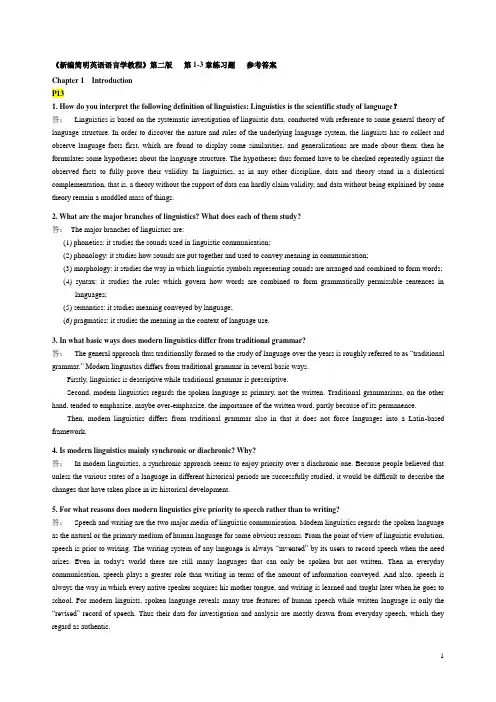
《新编简明英语语言学教程》第二版第1-3章练习题参考答案Chapter 1 IntroductionP131. How do you interpret the following definition of linguistics: Linguistics is the scientific study of language?答:Linguistics is based on the systematic investigation of linguistic data, conducted with reference to some general theory of language structure. In order to discover the nature and rules of the underlying language system, the linguists has to collect and observe language facts first, which are found to display some similarities, and generalizations are made about them; then he formulates some hypotheses about the language structure. The hypotheses thus formed have to be checked repeatedly against the observed facts to fully prove their validity. In linguistics, as in any other discipline, data and theory stand in a dialectical complementation, that is, a theory without the support of data can hardly claim validity, and data without being explained by some theory remain a muddled mass of things.2. What are the major branches of linguistics? What does each of them study?答:The major branches of linguistics are:(1) phonetics: it studies the sounds used in linguistic communication;(2) phonology: it studies how sounds are put together and used to convey meaning in communication;(3) morphology: it studies the way in which linguistic symbols representing sounds are arranged and combined to form words;(4) syntax: it studies the rules which govern how words are combined to form grammatically permissible sentences inlanguages;(5) semantics: it studies meaning conveyed by language;(6) pragmatics: it studies the meaning in the context of language use.3. In what basic ways does modern linguistics differ from traditional grammar?答:The general approach thus traditionally formed to the study of language over the years is roughly referred to as “t raditional gramma r.” Modern linguistics differs from traditional g rammar in several basic ways.Firstly, linguistics is descriptive while traditional grammar is prescriptive.Second, modem linguistics regards the spoken language as primary, not the written. Traditional grammarians, on the other hand, tended to emphasize, maybe over-emphasize, the importance of the written word, partly because of its permanence.Then, modem linguistics differs from traditional grammar also in that it does not force languages into a Latin-based framework.4. Is modern linguistics mainly synchronic or diachronic? Why?答:In modem linguistics, a synchronic approach seems to enjoy priority over a diachronic one. Because people believed that unless the various states of a language in different historical periods are successfully studied, it would be difficult to describe the changes that have taken place in its historical development.5. For what reasons does modern linguistics give priority to speech rather than to writing?答:Speech and writing are the two major media of linguistic communication. Modem linguistics regards the spoken language as the natural or the primary medium of human language for some obvious reasons. From the point of view of linguistic evolution, speech is prior to writing. The writing system of any langu age is always “invented” by its users to reco rd speech when the need arises. Even in today's world there are still many languages that can only be spoken but not written. Then in everyday communication, speech plays a greater role than writing in terms of the amount of information conveyed. And also, speech is always the way in which every native speaker acquires his mother tongue, and writing is learned and taught later when he goes to school. For modern linguists, spoken language reveals many true features of human speech while written language is only the “revised” record of spe ech. Thus their data for investigation and analysis are mostly drawn from everyday speech, which they regard as authentic.6. How is Saussure's distinction between langue and parole similar to Chomsky's distinction between competence and performance?答:Saussure's distinction and Chomsky's are very similar, they differ at least in that Saussure took a sociological view of language and his notion of langue is a matter of social conventions, and Chomsky looks at language from a psychological point of view and to him competence is a property of the mind of each individual.7. What characteristics of language do you think should be included in a good, comprehensive definition of language?答:First of all, language is a system, i.e., elements of language are combined according to rules.Second, language is arbitrary in the sense that there is no intrinsic connection between a linguistic symbol and what the symbol stands for.Third, language is vocal because the primary medium for all languages is sound.Fourth, language is human-specific, i. e., it is very different from the communication systems other forms of life possess.8. What are the main features of human language that have been specified by C. Hockett to show that it is essentially different from animal communication system?(2.2语言的识别性特征)美国语言学家C. Hockett提出了人类语言的12种识别性特征,其中最重要的识别性特种有5种:即语言的任意性、创造性、二重性、移位性和文化传递性。
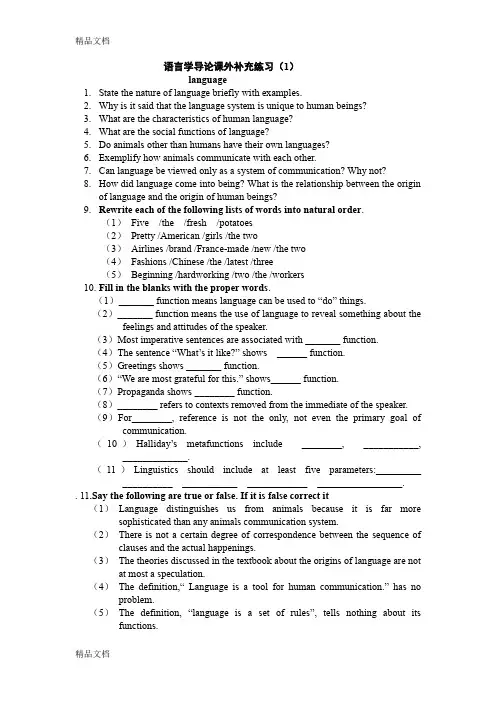
语言学导论课外补充练习(1)language1.State the nature of language briefly with examples.2.Why is it said that the language system is unique to human beings?3.What are the characteristics of human language?4.What are the social functions of language?5.Do animals other than humans have their own languages?6.Exemplify how animals communicate with each other.7.Can language be viewed only as a system of communication? Why not?8.How did language come into being? What is the relationship between the originof language and the origin of human beings?9.Rewrite each of the following lists of words into natural order.(1)Five /the /fresh /potatoes(2)Pretty /American /girls /the two(3)Airlines /brand /France-made /new /the two(4)Fashions /Chinese /the /latest /three(5)Beginning /hardworking /two /the /workers10.Fill in the blanks with the proper words.(1)_______ function means language can be used to “do” things.(2)_______ function means the use of language to reveal something about the feelings and attitudes of the speaker.(3)Most imperative sentences are associated with _______ function.(4)The sentence “What’s it like?” shows ______ function.(5)Greetings shows _______ function.(6)“We are most grateful for this.” shows______ function.(7)Propaganda shows ________ function.(8)________ refers to contexts removed from the immediate of the speaker.(9)For________, reference is not the only, not even the primary goal of communication.(10)Halliday’s metafunctions include ________, ___________, _____________.(11)Linguistics should include at least five parameters:_________ __________ ___________ ____________ _________________..11.Say the following are true or false. If it is false correct it(1)Language distinguishes us from animals because it is far more sophisticated than any animals communication system.(2)There is not a certain degree of correspondence between the sequence of clauses and the actual happenings.(3)The theories discussed in the textbook about the origins of language are not at most a speculation.(4)The definition,“ Language is a tool for human communication.” has no problem.(5)The definition, “language is a set of rules”, tells nothing about its functions.(6)Hall, like Sapir, treats language as a purely human institution.(7)Chomsky’s definition about language is the same as Sapir’s.语言学课外单元补充习题答案Language(Exercise 1)1. State the nature of language briefly with examples.Answer: modern linguists have proposed various definitions of language such as: Language is “a purely human and non-instinctive method of communicating ideas, emotion s and desires by means of voluntarily produced symbols.” (Sapir, 1921) Language is “the institution whereby humans communicate and interact with each other by means of habitually used oral-auditory arbitrary symbols.” (Hall, 1968) Language is “a set (fin ite or infinite) of sentences, each finite in length and constructed out of a finite set of elements.” (Chomsky, 1957)“语言是人跟人互通信息,用发音器官发出来的,成系统的行为的方式。
(二)填空1.古印度、古代中国、古希腊具有悠久的历史文化传统,是语言学的三大发源地。
2.文言是我国古代的书面语,用它写成的文章称为文言文。
3.文字学、音韵学、训诂学是我国传统的语文学。
4.研究语言的结构,主要是研究语音、词汇、语法三个部分。
5.运用语言传递信息的过程,可以分为编码、发送、传递、接收、解码五个阶段。
二、填空题1.人和动物的区别是人会制造工具,而且人类有语言,这人和动物相区别的重要标志之一。
2.一种语言中的句子数量是无限的,人类之所以能掌握语言,是因为构成句子的语法规则是十分有限的。
3.语言是人类社会的最重要的交际工具,而且也是思维的最有效的工具。
4.在一定条件下,身体姿势等伴随动作还可以离开语言独立完成交际任务。
例如汉民族点头表示同意,摇头表示不同意,送别时挥手表示致意,鼓掌表示欢迎,咬牙切齿表示愤恨,手舞足蹈表示激动或高兴。
5.人的大脑分左右两半球,大脑的左半球控制语言活动,右半球掌管不需要语言的感性思维。
6.汉语的哥哥、弟弟,英语用brother 表示,汉语的舅妈、姨妈、姑妈、婶婶,英语用aunt 表示。
7.英语可以直接用数词修饰名词,汉语数词修饰名词一般要加上一个量词。
8.儿童最早的智力活动就是学习语言。
三、判断题1.语言是人类最重要的交际工具。
(+)2.文字也是人类最重要的交际工具。
(-)3.语言是人类特有的,动物没有语言。
(+)4.没有语言,人类照样可以思维。
(-)二、填空题1.任何符号,都是由能指和所指两个方面构成的。
2.语言符号是能记和所记的统一体,声音是语言符号的能记。
3.用什么样的语音形式代表什么样的意义,完全是由使用这种语言的社会成员约定俗成。
4.语言符号具有音义结合的任意性和能指组合的线条性特点。
5.语言的底层是一套音位,上层是符号和符号的组合,可以分为若干级,第一级是词,第二级是词组,第三级是句子。
6.语言系统中的所有符号,既可以同别的符号组合,又可以被别的符号替换,符号之间的这两种关系是组合关系和聚合关系。
《语言学纲要》学习指导书课后练习题填空、判断、选择题参考答案导言一、填空1.语言学的三大发源地是中国、印度和希腊‐罗马。
2.语言学是19世纪成为独立学科的,其标志是历史比较语言学的出现。
3.现代语言学的标志性著作是瑞士语言学家索绪尔的《普通语言学教程》。
4.语言交际过程可分为编码、发送、传递、接收、解码五个阶段。
5.印度最早的经典所使用的语言是梵语。
6.文字、音韵、训诂是中国“小学”的主要内容。
二、判断正误1.语文学主要是研究古代的口语和书面语。
(×)2.语言有自身结构的独立性,与系统之外的社会环境没有关系。
(×)3.理论语言学是研究语言一般规律的,不受具体语言研究影响。
(×)4.语言形式和内容的关系是语言研究的根本问题。
(√)第一章语言的功能一、填空1.语言的功能包括(社会)功能和(思维)功能。
2.语言的社会功能包括(信息传递)功能和(人际互动)功能。
3.在各种信息传递形式中,(语言)是第一性的、最基本的手段。
4.人的大脑分左右两个半球,语言功能及计数、推理能力等由(左)半球掌管,音乐感知、立体图形识别等能力由(右)半球制约。
5.儿童语言习得一般经过(独词句)阶段和(双词句)阶段,这是儿童学话的关键两步。
二、判断正误1.文字是建立在语言基础之上的再编码形式。
(对)2.当说话者陈述一个客观事实时,话语中不具有主观性。
(错)3.书刊上的话语不具有人际互动功能。
(错)4.抽象思维要以语言为形式依托。
(对)5.布洛卡区在大脑的右半球前部。
(错)6.聋哑人不会说话,所以不具有抽象思维的能力。
(错)7.不同语言结构的差异体现出思维方式的不同。
(对)8.汉语名词没有数的变化,所以汉语没有区别单数和多数的概念。
(错)第二章语言是符号系统一、填空1.说出的话语句子是无限的,但无限多的句子都是由有限的(词汇材料)和(造句规则)组装起来的。
2.符号包含(形式)和(意义)两个方面,二者不可分离。
语言学全部习题1. 简答题(每题10分,共30分)1) 什么是语言学?语言学是研究语言的科学,包括语音学、词法学、句法学、语义学、语用学等不同的分支。
它关注语言的结构、用法、演变以及和思维、社会和文化之间的关系。
2) 语言的基本要素包括哪些?语言的基本要素包括语音、词汇、句法、语义和语用。
语音研究发音和音系,词汇研究词的形态和词义,句法研究语言的句子结构,语义研究词和句的含义,语用研究语言的使用和交际。
3) 语音学和音系学有何区别?语音学研究语言中的语音现象,包括语音的产生、传播和感知等方面。
音系学研究语言中的音素系统,即语言中所有可能出现的音位和它们的组合规则。
2. 选择题(每题10分,共40分)1) 下列哪个不属于语言的基本要素?A. 语音B. 词汇C. 句法D. 语文答案:D2) 以下哪个学科不是语言学的分支?A. 语音学B. 语用学C. 数学D. 词法学答案:C3) 语音学主要研究哪方面的内容?A. 词义B. 词形C. 词语的使用D. 语音的产生和感知答案:D4) 以下哪个不是语言学的研究对象?A. 词汇表B. 句子结构C. 语言和思维的关系D. 社会语言规范答案:A3. 简答题(每题10分,共30分)1) 什么是语言的演变?语言的演变是指语言在使用过程中,由于多种因素的影响,其语音、词汇、句法等方面发生变化和发展。
语言的演变是一个长期的、渐进的过程,涉及到语言交流者的语言习惯、语音产生的方式、语法规则的改变等方面的变化。
2) 语言和思维之间有何关系?语言和思维之间有密切的关系。
一方面,语言是人类思维的表达工具,通过语言的运用,人们能够将思维中的概念、情感和意图等传递给他人。
另一方面,语言也影响思维的方式和内容。
语言结构和词汇的差异会影响人们的思维方式,不同语言对概念的划分和认知方式可能会有所不同。
3) 什么是语言交际?语言交际指的是人们通过语言进行沟通和交流的过程。
语言交际包括语言的使用、理解和解释,以及交流中的非语言行为和语境等因素。
《现代汉语》(增订四版)补充练习题答案(全)-图文《现代汉语》(增订四版)课后补充练习答案刘小南(这里所列的,是主教材上、下册书后所附的“补充练习”的答案。
至于主教材各章节后的“思考与练习”的答案,都收在黄伯荣、廖序东主编的《现代汉语(增订四版)教学与自学参考》一书中,该书由高等教育出版社20xx年6月出版,书号7—04—021405—5)第一章绪论(一)绪论补充练习答案一1. 简述现代汉语口语和书面语的关系。
口语和书面语是现代汉语的两种不同形式。
书面语是写(印)出来的语言,口语是说出来的语言;书面语的物质载体是文字,口语的物质载体是语音。
从语言学的角度看口语和书面语的差别主要在风格方面。
口语的特点是亲切自然,句子简短,常有省略。
书面语的特点是用词精审,结构谨严,逻辑性强。
书面语是在口语的基础上形成并发展起来的。
先有口语,后有书面语;至今还有许多民族只有口语而没有书面语。
因此口语是第一性的,书面语是第二性的。
书面语比口语规范、连贯,因为写出来的话可以有时间斟酌、加工,乃至反复修改。
对书面语进一步加工规范,就形成标准语(又称“文学语言”)。
书面语与口语相互影响。
书面语的成分不断进入口语,从而使口语向着规范的方向发展;口语成分也不断被吸收进书面语,从而使书面语不断丰富生动。
书面语往往受到口语的制约,它虽然有自己的特点要形成自己的风格,同口语保持一定的距离,但不能距离太远。
如果书面语同口语脱节太严重,人们就会对书面语进行改革。
“五四”前后废除文言文提倡白话文的运动,就是因为文言文这种书面语同口语脱节太严重。
2. 汉语不大用形态变化,但不等于说没有形态变化,你能举出汉语有形态变化的事例吗?从事例中归纳一下,汉语有哪几种形态变化?结合事例,汉语主要有下面几种形态变化:(一)重叠。
如:认真→认认真真,讨论→讨论讨论,是构形形态。
(二)加前缀或后缀。
如:姨→阿姨,爱→可爱;想→想头,亮→亮儿,是构词形态。
3. 汉语在世界语言中有什么样的地位和影响?汉语是世界上历史悠久的、发展水平较高的语言之一。
《语言学概论》练习练习一(导论部分)填空题:1.语言学的研究对象是人类的语言。
2.以研究目的为标准,可以把语言学分为理论语言学和应用语言学两大类。
3.以研究对象为标准,可以把语言学分为个别语言学和普通语言学两大类。
《语言学概论》属于普通语言学,《现代汉语》属于个别语言学。
4.19世纪20年代以后,随着历史比较语言学的建立,语言学逐渐发展成为一门独立的科学。
5.我国语言学时期主要有三门学问,即文字学、训诂学和音韵学,它们被统称为“小学”。
6.瑞士语言学家索绪尔(费尔迪南?德?索绪尔)是结构主义奠基人,其代表作《普通语言学教程》在语言学史上占有十分重要的地位。
练习二(第一章语言的本质)一、名词解释:1.语言:从语言本身的结构来看,它是由词汇和语法构成的体系。
所谓词汇就是某种语言中词的总汇。
所谓语法就是把语言成分组织起来的各种规则和总和,语言的社会功能是语言作为人类最重要的交际工具和思维工具。
2.言语:言语不同于语言,所谓言语就是指说话和所说的话,言语的范围要比语言来得大。
3.任意性:语言符号的任意性就是语言符号的语音形式与意义内容的结合是任意的。
4.线条性:语言符号的线条性是指在交际过程中,语言符号或语言符号的语音形式,只能一个接着一个,前后相继,依次出现,随着时间的推移而延伸,不可能在同一时间里说出两个或两个以上的符号或声音。
5.组合关系:语言符号的各个要素前后依次相继出现,彼此相互联结的语言成分之间构成的关系就是组合关系。
每一种成分都有其特定的组合关系。
(横向的联系)6.聚合关系:处于同一个层级上的语言单位,由于它们具有共同的特点,就可以成为一种类别,同类的各成分之间具有的关系就是聚合关系。
(纵向的联系)二、填空题。
1.语言符号是音和义的结合体,语言符号的音义结合是任意的,没有本质的必然联系。
2.符号是指代某种事物的标记,它由形式和意义两部分构成。
符号的形式是人的感官可以感知的,符号的内容是形式所表达的意义。
第一章语言学入门知识:I. 名词解释1.cultural transmission (as a defining property of language) Answer: While human capacity for language has a genetic basis, the details of any language system are not genetically transmitted, but instead have to be taught and learned. An English speaker and a Chinese speaker are both able to use a language, but they are not mutually intelligible. This shows that language is culturally transmitted. It is passed on from one generation to the next through teaching and learning, rather than by instinct. In contrast, animal call systems are genetically transmitted. They are born with the capacity to produce the set of calls peculiar to their species.2.descriptive linguistics vs. prescriptive linguisticsAnswer: A linguistic study is descriptive if it describes and analyses facts observed; it is prescriptive if it tries to lay down rules for "correct" behavior. Linguistic studies before the 204 century are largely prescriptive whereas modem linguistic is mostly descriptive.II. 判断正误(T for True and F for False)1. When language is used to get information, it serves an informative function.Answer: F (It serves an interrogative function).2.Most animal communication systems lack the primary level of articulation.Answer: F (The primary units in these systems cannot be further divided into elements. So what they lack is the secondary level of articulation.) 3.Descriptive linguistics are concerned with how languages work, not with how they can be improved.Answer: TIII. 填空题1.By saying that "language is arbitrary", we mean that there is no logical connection between meaning and _______.Answer: sounds2.The distinction between langue and parole is made by the Swiss linguist E de Saussure. The distinction between competence and performance is made by the American linguist__________.Answer: Noam Chomsky3.An approach to linguistic study which attempts to lay down rules of correctness as to how language should be used is _______.Answer: prescriptiveIV. 选择题1.Unlike animal communication system, human language is ______.A. stimulus freeB. stimulus boundC. under immediate stimulus controlD. stimulated by some occurrence of communal interestAnswer:A2. ____ has been widely accepted as the forefather of modem linguistics.a. Chomskyb. Saussurec. Bloomfieldd. John LyonAnswer: bV. 问答题l. Is language productive or not WhyAnswer: Firstly, Language is productive or creative. This means that language users can understand and produce sentences they have never heard before. Secondly, Productivity is unique to human language. Most animal communication systems have a limited repertoire, which is rapidly exhausted, making any novelty impossible. Thirdly, The productivity or creativity of human language originates from its duality. Because of duality, the speaker can combine the basiclinguistic units to form an infinite set of sentences. The productivity of language also means its potential to create endless sentences. This is made possible by the recursive nature of language.2. Comment on the fo llowing statement: “In linguistics, ‘language’ only means what a person says or said in a given situation”.Answer: This statement is incorrect. In linguistics, "language" has several layers of meaning: firstly, the whole of a person’s language, . Shakesp eare’s language; secondly, a particular variety or level of speech or writing, . scientific language, literary language, colloquial language; thirdly, an abstract system underlying the totality of the speech/writing behavior of a community, . the English language, the Chinese language; lastly, there is an even more abstract sense of "language", referring to the common features of all human languages that distinguish them from animal communication systems or any artificial language.3. Point out three ways in which linguistics differs from traditional grammar.Answer: Firstly, most linguistic analyses today focus on speech rather than writing. Secondly, modem linguistics is mostly descriptive while traditional grammar is largely prescriptive. Thirdly, a third difference is the priority of synchronic description over the traditional diachronic studies.4. What is the major difference between Saussure' s distinction between langue and parole and Chomsky's distinction between competence and performanceAnswer: S aussure’s langue is social product, a set of conventions for a speech community. Chomsky regards competence as a property of the mind of each individual. Saussure studies language more from a sociological point of view while Chomsky studies it more from a psychological point of view.第二章语音学和音位学I. 名词解释1.narrow transcriptionAnswer: There are two ways to transcribe speech sounds. One is the “broad transcription”----the transcription with letter-symbols only, and the other is “narrow transcription”---the transcription with letter-symbols accompanied by the diacritics which can help bring out the finer distinctions than the letters alone may possibly do.2. Illustrate the term “allophone” with at least one appropriate example. Answer: Allophones are the different members of a phoneme, sounds which are phonetically different but do not make one word different from another in meaning. For example, in English, the phoneme /l/ is pronounced differently in "let", "play" and "tell". The first /l/ is made byraising the front of the tongue to the hard palate, while the vocal cords are vibrating; the second /l/ is made with the same tongue position as the first, but the vocal cords are not vibrating; and the third /l/ is made by raising not only the front by also the back of the tongue while the vocal cords are vibrating.II 判断正误(T for True and F for False)1. /o/ is a mid-high front rounded vowel.Answer: F. (/o/ is a mid-high BACK rounded vowel.)2. A phoneme in one language or one dialect may be an allophone in another language or dialect.Answer: T.III. 填空题:1. The three cavities in the articulatory apparatus are _____, _______, and _____.Answer: pharynx, the nasal cavity, the oral cavity2. By the position of the ____ part of the tongue, vowels and classified as front vowels, central vowels and back vowels.Answer: highest.3. ____refers to the change of a sound as a result of the influence of an adjacent sound.Answer: Assimilation.4. You are required to fill in the blanks below abiding by the instance given beforehand.Example: /p/: voiced bilabial stop/s/: ________________/g/:_______________/t/:______________/t/: _______________/f /: _______________Answer:/s/: voiceless alveolar fricative/g/: voiced velar stop/t/: voiceless alveo-palatal/post-alveolar affricate/ t /: voiced dental fricative/f /: voiceless labiodental fricative5. Which of the following words would be treated as minimal pairs and minimal setspat, pen more, heat, tape, bun, fat, ban, chain, tale, bell, far, meal, vote, bet, heel, ten, men, pit, main, hit, eat, manAnswer:pat, fat; pat, pit; pit, hit;pen, ten; ten, men;heat, eat; heat, heel;tape, tale;bun, ban;chain, main;bell, bet;meal, heel;man, men, main.IV. 选择题1. All syllables contain a(n) _______.a. nucleusb. codac. onsetAnswer: a2. _____is one of the supersegmental features.a. Stopb. Voicingc. Deletiond. ToneAnswer: d3. Which of the following consonants does not exist in Englisha. dental stopb. bilabial stopc. alveolar stopd. velar stopAnswer: a4. _____is not an English consonant.a. Labiodental plosiveb. Alveolar nasalc. Velar stopd. Dental fricativeAnswer: aV. 辨音选择1. What are the distinctive features that group the following sounds in these sets1) /f, v ,s/2) /p, f, b/3) /g, z, b/4) /k, g, w/5) /m, n, /Answer: 1) fricative 2) obstruent 3) voiced 4) velar5) nasal2. There is one segment that does not belong to the natural class in each of the following groups of speech sounds. You are required to identify that segment and label the natural class, using a descriptive term as specific as possible.a) /m/, /n/, /w/, / /b) /v/, /w/, /z/, /t/c) /n/, /f/, /l/, /s/, /t/, /d/, /z/Answer:1) /w/ is a semi-vowel, and the others are all nasals.2) /t/ is voiceless, and the others are voiced.3) /f/ is labiodental, and the rest are alveolarVI. 问答题1.Circle the words that contain a sound as required:1) a low vowel: pipe, gather, article, leave, cook2) a bilabial consonant: cool, lad, leap, bomb, push3) an approximant: luck, boots, word, once, table4) a front vowel: god, neat, pit, lush, cook5) a velar: god, fast, chat, lake, quick2.Exemplify the relationship between phone, phoneme and allophone. Answer: Firstly, a “phone” is a phonetic unit or segment. The speech sounds we hear and produce during linguistic communication are all phones. Phones may or may not distinguish meaning. Secondly, a "phoneme" is a phonological unit that is of distinctive value. As an abstract unit, a phoneme is not any particular sound. It is represented or realized by a certain phone in a certain phonetic context. Thirdly, thephones representing a phoneme are called its "allophones". How a phoneme is represented by a phone, or which allophone is to be used, is determined by the phonetic context in which it occurs. But the choice of an allophone is not random but rule-governed in most cases. 3.When we are pronouncing the following phrases, how do we actually articulate the "n" sound in the word "ten" Do we still pronounce it as /n/ 1) ten houses 2) ten teachers 3) ten colleges 4) ten pupils 5) ten buildings 6) ten classesAnswer: 1) /n/2) /n/3) / /4) /m/5) /m/6) / /4.How many functions do the vocal cords have in the production of speech soundsAnswer: They have three functions: to make a glottal stop, to produce a voiced sound and to produce a voiceless sound.第三章形态学I. 名词解释1.morphemeAnswer: The morpheme is the smallest unit in terms of relationship between expression and content, a unit which cannot be divided without destroying or drastically altering its meaning, whether it is lexical or grammatical. For instance, the word "barks" in "The dog barks" consists of two morphemes ― "bark" and "-s", neither of which can be further divided into other smaller meaningful units.2.lexemeAnswer: The term "lexeme" is postulated to reduce the ambiguity of the term "word". It is the abstract unit underlying the smallest unit in the lexical system of a language, which appears in different grammatical contexts. For example, "write" is the lexeme of the following set of words: "writes", "wrote", "writing", "written".3.inflectional morphemesAnswer: Inflectional morphemes are also called inflectional affixes. They manifest various grammatical relations or grammatical categories suchas number, tense, degree and case. In English, all inflectional morphemes are suffixes, . -(e)s, -ing, -(e)d, -est.II. 判断正误1.A root is not always a free form.Answer: T (There are such bound roots as “-ceive”.)III. 填空题1.Polymorphemic words other than compounds have two parts: the roots and the ____.Answer: affixes2.On, before and together are_____words ― they are words which do not take inflectional endings.Answer: grammatical (functional/form)IV.选择题1."Radar" is a/an____.a. acronymb. blendingc. coinaged. clippingAnswer: a2.Compound words consist of______ morphemes.a. boundb. freec. both bound and freeAnswer: bV. 匹配题Match each expression under A with the one statement under B that characterizes it.A B1. a noisy crow a. compound noun2. eat crow b. root morpheme plus derivational prefix3. scarecrow c. phrase consisting of an adjective plus noun4. the crow d. root morpheme plus inflection affix5. crowlike e. root morpheme plus derivational suffix6. crows f. grammatical morpheme followed by lexical morphemeg. idiomAnswer: 1. c 2. g 3. a 4. f 5. e 6. dVI. 问答题1. Divide the following words into Roots, IA (inflectional affix) and/or DA (derivational affix).1) transformations 2) looseleaves3) destructive 4) geese 5) misledAnswer:1) trans- (DA) form (Root) -ation (DA) s (IA)2) loose (Root) leave (Root) s (IA)3) de- (DA) struct (Root) -ive (DA)4) geese (IA)5) mis- (DA) led (IA)2. Label the morphological category of the morphemes underlined in each of the English expressions.a) I' ve been here.b) transformc) oxend) recurAnswer: a) bound morpheme b) derivational prefix c) inflectional suffix d) bound root3. Each of the following Persian words is poly-morphemic. You are required to match each of the notions given below with a morpheme in Persian. (Note that xar means "buy" and -id designates the past tense). xaridiYou (singular) bought. naxaridamI did not buy. namixaridandThey were not buying. xaridHe bought.naxaridimWe did not buy. mixaridHe was buying. mixarididYou (plural) were buying. xaridamI bought.Match each of the notions given below with a morpheme in Persian:a) Ib) you (singular)c) notd) was/were V-ing (continuous)Answer: a) amb) ic) nad) miVid4.It is a fact that morphological processes may be sensitive to certain phonological context. The English data given below illustrate this fact. You are required to state the phonological contexts where the addition of -en is possible.a bwhiten *bluenmadden *stupidenredden *greenenFatten *fartheren quicken *slowendeafen *difficultenLiven *abstractenharden *shallowensoften *angryendeepen *vividenAnswer: The suffix -en, which attaches to adjectives to form verbs, can only attach to monosyllabic bases ending in oral stops or fricatives. VerbAdjective-en if Adjective ends in an obstruent (oral stop or fricative).- <Φ> if Adjective ends in a sonorant (nasal, approximant, vowel) Meaning: to make (more) Adjectives5.The word uneasiness may be analyzed in either of the two ways below. You are required to find an argument to support one of the two analyses.a)NPrefixNoununAdjectiveSuffixeasinessb)NAdjectiveSuffixPrefixAdjectivenessuneasiAnswer: b) is the correct analysis, because un- only attaches to adjectives to form other adjectives. Un- cannot be attached to a noun.。